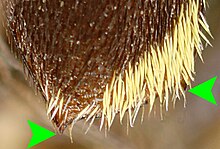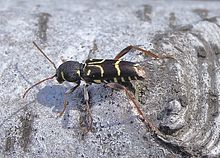Petite ram
| Petite ram | ||||||||||||
|---|---|---|---|---|---|---|---|---|---|---|---|---|

Dainty ram on beech bark |
||||||||||||
| Systematics | ||||||||||||
|
||||||||||||
| Scientific name | ||||||||||||
| Xylotrechus antelope | ||||||||||||
| ( Schönherr , 1817) |
The Petite Aries Bock or antelope buck ( Xylotrechus antelope ) is a beetle of the family of longhorn beetles (Cerambycidae). The species belongs to the subfamily Cerambycinae and within this group to the tribe Clytini .
features
The beetle becomes seven to fifteen millimeters long. Because of the very similar yellow drawing of the elytra, Xylotrechus antilope can easily be confused with Xylotrechus ibex , Xylotrechus capricornis , Xylotrechus arvicola and some species of the genus Clytus , especially Clytus lama and Clytus rhamni .
The head (Fig. 1) is wrinkled (shagreen) rather finely leather-like. Before the Einlenkungsstellen the probe is turned to face a keel in front of the eyes to the mouth parts continues down. In the middle of the forehead, two further longitudinal keels run parallel to each other, which unite at the front and rear ends. In contrast to Xylotrechus arvicola, these are only weakly developed, often only hinted at , they are absent in the genus Clytus . Between the middle and outer keels, the head is sparsely pale yellow - not dense yellow as in Xylotrechus arvicola -, short and haired outwards. The hair is thicker in the recess of the eyes next to the antenna deflection. The eleven-link antennae are thread-shaped in the first half and somewhat thicker in the second half.
The pronotum (Fig. 2) is bordered in front and at the base. It is not hairy as it is in the Clytus species. In contrast to Xylotrechus antilope , the greatest width of the pronotum is only a little behind the middle, not clearly behind the middle. When viewed from above, the pronotum is evenly rounded in outline, not the widest point protruding slightly angular. Unlike in Xylotrechus ibex , Xylotrechus capricornis and in the Clytus species, the puncture on the back of the pronotum produces clear transverse wrinkles in the first two thirds, while the puncture is much less coarse further back and to the sides. At the base of the pronotum there are two yellow spots on the sides, on the front edge a transverse band with a wide interruption in the middle, from above one can often only see a spot of roughly the same size in each corner of the cervix.
The label (Fig. 5) is roughly semicircular and has yellow hair on the back.
The elytra are slightly wider at the shoulders than the pronotum and a little less than three times as long as this. They narrow more towards the rear than in Xylotrechus arvicola . They end at an angle, with the angle at the seam being greater than the angle at the outer edge of the wing cover (Fig. 3, the apex of the angle indicated by green arrows). The end of the abdomen is mostly partially uncovered by the wing covers. The wing covers have two extensive yellow bands and other yellow spots. The front band begins a little behind the label near the wing cover suture, increases backwards from the suture, then bends less abruptly than with Xylotrechus arvicola and ends perpendicular to the body axis at the outer edge of the wing cover. The back band runs inwards slightly forwards, meets the corresponding band on the other wing cover at the seam and widens slightly towards the front. In addition, the tips of the elytra are hairy yellow (Fig. 3), on the side of the label there is a small transverse yellow spot (Fig. 5), and a short, line-shaped yellow spot runs from the front outside to the back inside.
The beetle also has a wasp drawing on the underside (Fig. 4).
Occurrence
The petite ram is considered to be rare and therefore only occurs sporadically in Germany, but is widespread in all federal states except Schleswig-Holstein. The species is found on the sunny edges of deciduous forests with oaks. Outside Europe, it is also widespread in North Africa, the Middle East , the Caucasus and Transcaucasia .
Way of life
The larvae develop in damaged or dead branches of oak trees. In the first year they eat tunnels under the bark , but later also penetrate the sapwood , where they pupate. The diurnal adults hatch in May. Mating and oviposition take place in June / July, when they are particularly active. The petite ram flies around on hot days and occasionally visits flowers or sunbathes on felled oak trunks. The beetles are active until August, after which they overwinter and are active a second time in the following summer.
swell
literature
- Georg Möller, Reiner Grube and Ekkehard Wachmann : The Fauna-Käferführer I - Beetles in and on the forest. Fauna Verlag, Nottuln 2006 ISBN 3-935980-25-6 .
- Jürgen Trautner, Katrin Geigenmüller and Ulrich Bense: Käfer I. Observe and determine. Naturbuch-Verlag, Augsburg 1992 ISBN 3-89440-529-5 .
Individual evidence
- ↑ Edmund Reitter : Fauna Germanica - The beetles of the German Empire. Volume 4, KG Lutz, Stuttgart 1912
- ^ E. Mulsant, Histoire naturelle des coléoptères de France Volume 2, Longicornes, Paris 1862–1863 Description as Clytus antilope p. 152
- ↑ Identification key coleo-net genus Xylotrechus >
- ↑ M. Drees: A current record of the longhorn beetle Xylotrechus antilope in the Ardey (Coleoptera: Cerambycidae). Nature and Homeland, 69th year, issue 2, Westphalian Museum of Natural History, 2009
Web links
- Fauna europaea taxonomy
- Xylotrechus antilope (Schönherr, 1817) cerambyx.uochb.cz (profile with picture, English)
- Petite ram, antelope buck - Xylotrechus antilope natur-in-nrw.com (description and pictures, German)




